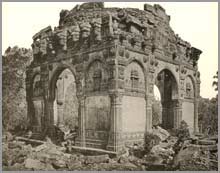Collection Archives
 Although, the photographic documentation of India’s architectural topography had conclusively begun by the mid 1850's, it was pursued as a government-directed policy only after the formal establishment of the British Empire of India, and with it the British anxieties of retaining it. From the 1880's concerned efforts were made to make the ‘listing’ more systematic, and included plans to preserve and restore selected ‘Hindu’, ‘Buddhist’ and ‘Mahomedan’ buildings in, mainly, British India (Figures 9 & 10). This ‘archaeological’ work, however, suffered due to the inadequate political will of the Colonial government, which consistently failed to disburse adequate funds for the projects, and allowed the formal termination, in 1889, of the Archaeological Survey of India, the organisation that was to centralize and direct much of this work.
Although, the photographic documentation of India’s architectural topography had conclusively begun by the mid 1850's, it was pursued as a government-directed policy only after the formal establishment of the British Empire of India, and with it the British anxieties of retaining it. From the 1880's concerned efforts were made to make the ‘listing’ more systematic, and included plans to preserve and restore selected ‘Hindu’, ‘Buddhist’ and ‘Mahomedan’ buildings in, mainly, British India (Figures 9 & 10). This ‘archaeological’ work, however, suffered due to the inadequate political will of the Colonial government, which consistently failed to disburse adequate funds for the projects, and allowed the formal termination, in 1889, of the Archaeological Survey of India, the organisation that was to centralize and direct much of this work.
As we are all aware, it is not photographs themselves, but a collection of them that creates a portfolio of a documentary record. Hence, intrinsic to the official policies of documenting the architectural topography of British India was the provision for reference archives. The British Government forged the institutionalisation of such archives through a proposal in 1869 for collecting and archiving “photographs, drawings, plans, sections and other architectural drawings, models, moulds and casts” (Forbes Watson 1869, p. i). Formally submitted by John Forbes Watson, the Director of the India Museum, London, the proposal, Report by Dr Forbes Watson on the Illustration of the Archaic Architecture, &c., of India, drawn by Fergusson, Cunningham and Phillip Meadows Taylor, was essentially a recommendation of what to collect. The intentions of the contributors were to build up duplicate collections of illustrative material on India, and as Forbes Watson enunciated––“copies of the whole of the photographs, plans, sections, &c., should be taken in duplicate, one set to be retained in India and the other forwarded to this country. The negatives … should in all cases be sent with the photographs to this Office” (ibid, p. 5). Secured firmly within the British metropolis, and parented through the institution of the India Office, this extensive collection of architectural photographs, prints and drawings at London facilitated various history-making enterprises on India, away from the country, its sites and its people.
themselves, but a collection of them that creates a portfolio of a documentary record. Hence, intrinsic to the official policies of documenting the architectural topography of British India was the provision for reference archives. The British Government forged the institutionalisation of such archives through a proposal in 1869 for collecting and archiving “photographs, drawings, plans, sections and other architectural drawings, models, moulds and casts” (Forbes Watson 1869, p. i). Formally submitted by John Forbes Watson, the Director of the India Museum, London, the proposal, Report by Dr Forbes Watson on the Illustration of the Archaic Architecture, &c., of India, drawn by Fergusson, Cunningham and Phillip Meadows Taylor, was essentially a recommendation of what to collect. The intentions of the contributors were to build up duplicate collections of illustrative material on India, and as Forbes Watson enunciated––“copies of the whole of the photographs, plans, sections, &c., should be taken in duplicate, one set to be retained in India and the other forwarded to this country. The negatives … should in all cases be sent with the photographs to this Office” (ibid, p. 5). Secured firmly within the British metropolis, and parented through the institution of the India Office, this extensive collection of architectural photographs, prints and drawings at London facilitated various history-making enterprises on India, away from the country, its sites and its people.
